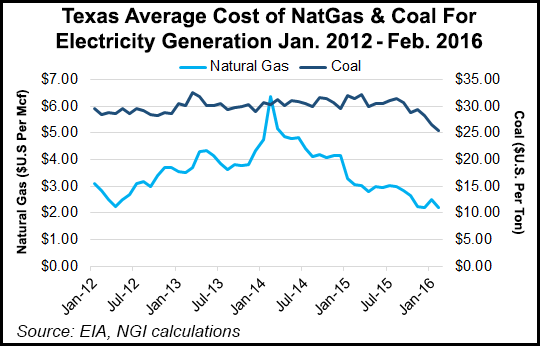Infrastructure | NGI All News Access
NatGas, Renewables Can Satisfy Texas’ Future Power Needs, Report Says
Predicting long-term low natural gas prices and declining costs of solar energy, researchers at the Brattle Group have concluded that gas-fired and renewable-sourced generation can satisfy Texas’ future electricity needs.

In a report released Tuesday, the researchers conclude that market forces will create that future for the two energy sectors over the next two decades.
Texas’ historic energy leadership will be broadened into clean energy behind continually advancing gas extraction methods, more utility-scale solar photovoltaic (PV) projects and the nation’s largest fleet of wind projects, according to Ira Shavel, an energy economist at Brattle. His report notes that it is “very possible” gas prices will stay below $4/MMBtu and “solar prices will continue to drop significantly.”
“Over the next 20 years, due to the free market alone, ERCOT [Electricity Reliability Council of Texas] can expect to see a cleaner grid that relies on Texas-produced natural gas, wind and utility-scale PV solar power at little additional cost to consumers,” Shavel said.

The report is part of a series begun by Brattle in 2013 with the Texas Clean Energy Coalition (TCEC), examining the relationship of natural gas and renewables in Texas, a state with abundant supplies of both. ERCOT was a natural focus for such a multi-phased analysis, coming at a time of increasingly plentiful gas supplies and a proactive effort in Texas to deregulate its electricity market.
Part IV of the series looked at how market forces can create a clean ERCOT grid, increasingly relying on in-state gas and renewable resources.
The report envisions more gas replacing coal-fired generation, gas-fired power to back up wind and solar, and “currently proposed environmental regulations will be largely irrelevant.” Brattle’s conclusion is that market forces — not more regulations — will reduce carbon dioxide emissions below the new standards proposed by the U.S. Environmental Protection Agency.
TCEC Chairman Kip Averitt, a former state senator and chair of the state Senate Natural Resources Committee, said the market transition is possible because of a combination of past state policy changes, including adoption of renewable portfolio goals, deregulating the electricity market in the state, and creating competitive renewable energy zones for new electric transmission lines to bring wind and solar supplies from western parts of the state to its large markets in the east.
Averitt touted the new report as a means to “prevent distortions” that might interfere with the state’s ongoing transition to “a cleaner, cost-effective electric grid” through increased gas and renewable use.
© 2024 Natural Gas Intelligence. All rights reserved.
ISSN © 1532-1231 | ISSN © 2577-9877 |
